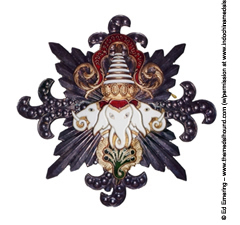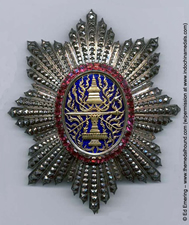Website Map
T'ai Federation and Nung Autonomous Zone
People's Republic of Kampuchea
Lao Peoples Democratic Republic
__________________
Associated Links
Cambodian Decorations from 1954 to the Present, book (Geoffrey Oldham)
Decorations and Medals of the Republic of Vietnam, book (John Sylvester and Frank Foster)
Medals of the Socialist Republic of Vietnam, book series (Ed Emering)
The Traditional Awards of Annam, book (John Sylvester and André Hüsken)
 |
This study lists and comments on the orders, decorations, and medals of Indochina. Indochina covers the areas of modern Vietnam, Cambodia, and Laos. The areas of this study on this website include:
- The Protectorate of Annam |
 |
Other areas of Indochina are covered by others as noted in the Associated Links on the lower left.
Site updates listed here.
In this study there are certainly errors and omissions. The earlier regimes in Indochina are destroyed. The records and memories that can be examined are mostly those abroad. In regard to some awards mysteries remain. Any additional assistance, information, other examples, etc are highly appreciated. Please contact me at rdavemail-medals@yahoo.com.
We want to acknowledge with deep gratitude for their assistance to Mr. Geoffrey Oldham, Mr. J. Hass, Mr. Ken Conboy, Col. P. Ruttier, Col. A. Guaydier, Mr. Victor Petrakov, Mr. Peter Groch, Mr. Maurizio Fumagalli, Mr. John Pieratt, Mr. Anton Fox, Mr. Barry Faulconbridge, Mr. Clement V. Kelly, Mr. Mario Flores, Mrs. Helen Moser, Mr. Jan-Olaf Larrson, Mr. Karl Fritch, Mr. George Petersen, Mr. Carl A. Anderson, Mr. Bongsavath Boulon, Mr. Giok Po Oey, Mr. Emmanuel Halleux, Mr. Frederic de Perier, Mr. Luc Farhi, Mr. Robert Sensio, Mr. E.J. Fischer, Mr. Jeff Floyd, and Mr. Edward J. Emering.
This study was initially carried out by John Sylvester Jr. We are thankful that he has let us take up this study from his original work, and continue to expand it with additional information as available.
| David Fay | ||
| rdavemail-medals@yahoo.com |
Medals:
Medals are symbols of man's courage, distinction, and vanity. At present in the United States, few, except military and naval officers in the occasional formal ceremony, wear their medals. Upon receipt, medals are usually stowed away in a drawer. The fashion is republican simplicity. Americans are amused at old photographs of bemedalled foreign officials and officers in their embroidered tailcoats and cocked hats. But that was the style of the time. And even now, medals please the recipient. At most a few dollars of metal, enamel, and ribbon, these may be valued far more than a large gift of money. Abroad, both in democracies and communist states, medals are still awarded and frequently worn with pride. In Indochina before 1975 and even now this is particularly true.
Medals are also symbols of history, and reflect the wars, changes of regime, and the characters of states. They perhaps do not deserve major scholarship, but they do deserve some study, and perhaps particularly so in Indochina. In modern history Indochina has seen traditional monarchy, imperialism, nationalist rebellion, communist revolution, and great power conflict. Along with the people of Indochina, French, Chinese, Americans and many other foreigners lived and fought there. Many left with intense and conflicting emotions. All too many have suffered and died there.
Indochina is an appropriate name for the area. While an early center of civilization in its own right, it became the site of dominating and contending Indic and Sinic cultures. The Vietnamese, under the sway of Chinese civilization, pressed against the Cham, Khmer, Lao, and Thai who adopted and adapted Hinduism and Terevada Buddhism. French Indochina encompassed territories of both cultures, as well as of the different world of the highland peoples. Laos and Cambodia were close to Thailand, which is sometimes included in the term Indochina, and their medals often bear similar themes and designs, some drawn from the Sanskrit epic, the Ramayana, which was embraced but heavily adapted in Cambodia and Laos. In Laos, for instance, the epic took place in Laos itself, with Ravanna, remade as a handsome young man called Raphanasvane, the principal hero.
A comment is sometimes made herein on the rarity of each award. This pertains not necessarily to how often the award has been made, but to how often the medal appears on the militaria market such that it can be bought by collectors. With the overthrow and destruction of the respective countries, most of the earlier orders and medals are obsolete and no longer issued. The major orders were widely bestowed, available for purchase in Haioi, Saigon, Phnompenh, Vientiane, and Paris, and come up frequently for sale. Some of the medals, particularly local made ones, can be hard to find. Most of the communist awards come out of dealers in Saigon and Bangkok, and can be plentiful or scarce, depending on the piece. The quality of medals also varies widely - as they were meant for wear, then they are usually found used. A few of the medals can nearly only be found dug from the ground, particullary from the late Kingdom and Rebublic of Cambodia where having these awards was a magnet for execution by the Khmer Rouge. Rather than detracting from the value as with coins, "used" medals can often be even more valueable especially when they are together with the original awarding documentation.
However, Caveat emptor. Sometimes previously scarce medals can suddenly appear in numbers for sale, as caches or continued stock from manufacturers in Paris are brought to market. Bags of some medals may be held by dealers in Saigon or Bangkok, which also may suddenly come onto the market. At time, however, some medals that used to be seen periodically for sale seem to disappear from the market. Medals are also reported to be currently being re-manufactured in Vietnam, Thailand, and perhaps elsewhere too. The prices of these medals, of course, obey the economic laws of supply and demand. While many of the medals are rare, collectors of these medals are sometimes even rarer.
History of the Studies on the Orders and Medals of Indochina :
In early May, 1970, the American 11th Armored Cavalry Regiment engaged in a short firefight in the town of Snoul as it entered Cambodia. At the time John Sylvester Jr. was the Senior Advisor in the Vietnamese province of Binh Long, north of Saigon on the border. Right after the engagement he tagged along on a helicopter with the II Field Force Commander and his Deputy for the pacification program to visit Snoul. They met there officers of the 11th, and the French rubber planters who had just been freed. After the fall of Prince Sihanouk, they had been held by the North Vietnamese units who so long had taken sanctuary in the forests in Cambodia near these plantations. Wandering around, he picked up a couple of souvenirs of the battle, including a North Vietnamese 51 caliber cartridge and what looked like a strip of ribbon for a medal. A year later, visiting a military goods store in Phnom Penh, he found that the ribbon actually was for a Cambodian medal, although why it should have been on the battlefield is puzzling. While at the store, he bought out of curiosity a few pieces of Cambodian ribbon and several medals. That hooked his interest in collecting and researching the medals of Indochina.
These studies on the orders and medals of Indochina were originally published in the series of six monographs on the orders of medals of Indochina by John Sylvester Jr. during 1986-1992. These original studies have been continued on and expanded by John Sylvester Jr. together with Ed Emering, Geoffrey P. Oldham, Frank Foster, André Hüsken, and myself.
The parts of the study on Indochinese awards covering the Kingdoms of Cambodia and Laos and their successive communist governments, were continued on by Ed Emering and John Sylvester Jr in 2001 in an updated book of the original series - however it was not published. I have continued on with this part of the study where they left off. This was the starting point for this website and its assocated books.
The parts of the study on Indochinese awards covering Cambodia, Laos and French Indochina, are partially included by Ed Emering as part of The Medalhound website http://www.themedalhound.com/medalindex.html and in the book "Orders, Decorations and Medals of the French Colonial Empire and the Post-Colonial Period", by Edward John Emering - available at http://www.themedalhound.com/books/titles.html. Also, see "The Official The Imperial Order of the Dragon of Annam Website" at http://www.themedalhound.com/orderOfDragon/index.html
The part of the study on Indochinese awards covering the Kingdom of Cambodia from 1954 to the present, including the People's Republic of Kampuchea, and the current Kingdom of Cambodia, has been continued on by Geoffrey P. Oldham & Brett Delahunt in the book "Cambodian Decorations of Honor" - available at http://www.milimem.com. Particular depth is covered for the People's Republic of Kampuchea and the current Kingdom of Cambodia - for which should be referred beyond the brief coverage in these more modern areas here.
The part of the study on Indochinese awards covering the medals of French Indochina has been continued on by myself, in this website and assocated book.
The part of the study on Indochinese awards covering the later orders and medals of Vietnam, and those of the other associated countries in the wars of Indochina, has been continued on by Col. Frank Foster and John Sylvester Jr. in the book "The Decorations and Medals of the Republic of Vietnam, and Her Allies 1950-1975", MOA Press, 1995 - available at www.amazon.com.
The part of the study on Indochinese awards covering the Socialist Republic of Vietenam has been continued by Ed Emering in the series of books on SRV orders and medals "Orders, Decorations and Badges of the Socialist republic of Vietnam, and the National Front for the Liberation of South Vietnam", "Encyclopedia of the Orders, Decorations, Medals and Badges of the Socialist Republic of Vietnam", and "Orders and Decorations of the Socialist Republic of Vietnam: An Update", and other articles. The books are available at http://www.themedalhound.com/books/titles.html.
The part of the study on Indochinese awards covering "The Traditional Awards of Annam: The Khánh, Bôi, Tiên, and Bài" which cataloged those of the Court of Hué, including the gold and silver Tiên which came later to be worn in the European fashion with ribbons, has been continued on by André Hüsken and John Sylvester Jr. in the book "The Traditional Awards of Annam" available at : http://www.huesken.com (in English, French, and German).
References: John Sylvester Jr., "The Things We Die For" Ch36 of The Banana Sculpter, The Purple Lady, and the All-Night Swimmer, by Susan Sheehan and Howard Means, 2002 (available at www.amazon.com).